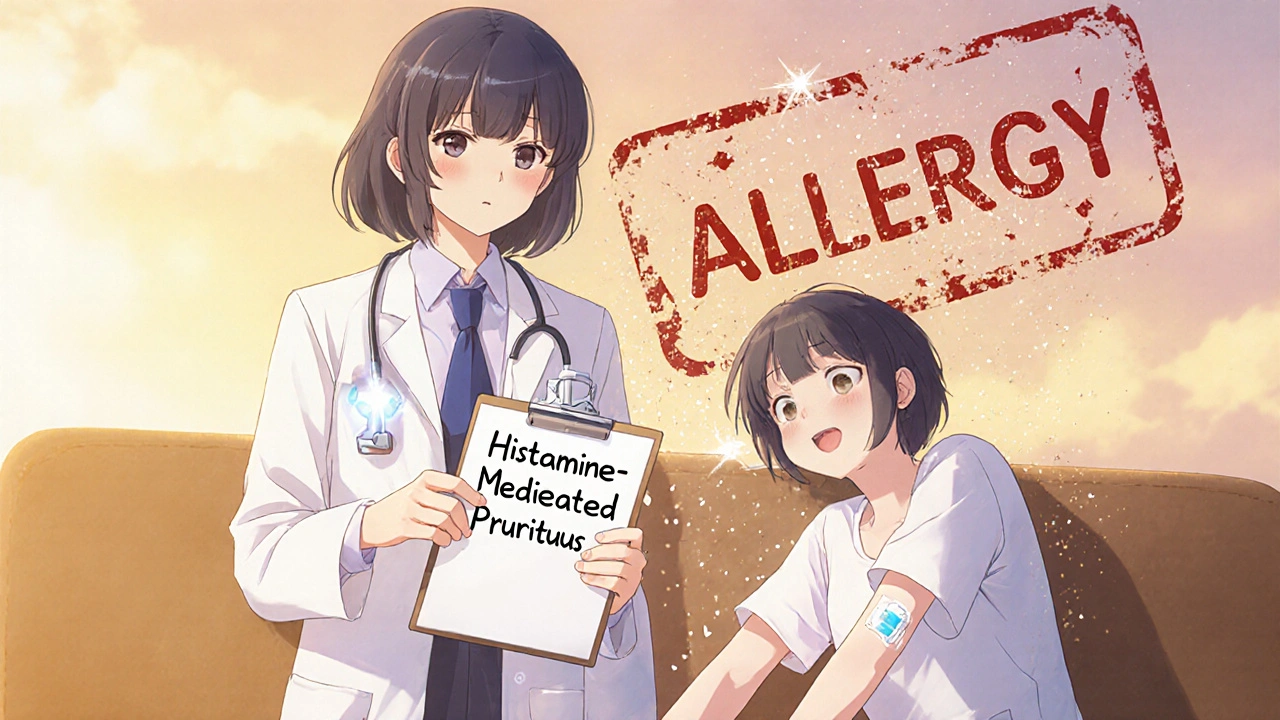Itching after taking an opioid like morphine doesn’t mean you’re allergic. In fact, most people who say they’re allergic to opioids aren’t. They’re just experiencing a common side effect that’s been mislabeled for decades. If you’ve ever felt that annoying, full-body itch after a painkiller and were told to avoid all opioids because of it, you’re not alone - and you’re probably not truly allergic.
Itching Isn’t an Allergy - Most of the Time
When you get itchy after an opioid, it’s usually not your immune system going haywire. It’s your mast cells releasing histamine directly, like a faucet turned on by the drug itself. This is called a pseudoallergic reaction. It looks like an allergy - redness, flushing, sneezing, and yes, intense itching - but it doesn’t involve IgE antibodies or T-cells. No immune memory. No future danger. Just a chemical reaction.
Studies show 70 to 80% of people who report an opioid allergy actually have this kind of reaction. The most common trigger? Morphine. It releases 3 to 4 times more histamine than hydromorphone at the same pain-relieving dose. Codeine does the same. Fentanyl? Almost none. Methadone? Very little. That’s not random - it’s chemistry. Morphine’s molecular structure has a specific group that triggers mast cells. Fentanyl doesn’t. So if you got itchy on morphine but not on a fentanyl patch, you’re not allergic. You’re just sensitive to histamine release.
What a Real Opioid Allergy Actually Looks Like
True opioid allergies are rare - affecting only 0.1% to 0.3% of people who take them. But they’re serious. These aren’t just itchy skin. They’re systems crashing. Hives that spread fast. Swelling of the lips, tongue, or throat. Trouble breathing. A sudden drop in blood pressure. Anaphylaxis. These reactions happen within minutes, often after the very first dose, and require emergency treatment.
If you’ve ever had your throat close up after morphine, or your face puffed up so badly you couldn’t open your eyes, that’s a true allergy. If you’ve ever needed epinephrine, or ended up in the ICU, you’re in that tiny group. That’s when you need to avoid all opioids - or at least the ones that cross-react. But if you just got itchy and took Benadryl and it went away? You’re not in that group.
Why Mislabeling Matters
Calling itching an allergy has real consequences. Doctors stop prescribing opioids. Patients get less effective pain control. They’re stuck with weaker drugs, more side effects, or worse - unmanaged pain. In hospitals, a patient labeled “allergic to morphine” might get a much more expensive alternative like fentanyl or hydromorphone, even if they could’ve tolerated morphine with a simple antihistamine.
One study found mislabeled opioid allergies cost the U.S. healthcare system $1,200 per patient in extra drug costs. Multiply that by 10 to 15% of all opioid users - that’s $24 to $36 billion a year. And it’s not just money. It’s quality of life. Cancer patients, post-surgery folks, chronic pain sufferers - they’re the ones paying the price with discomfort and sleepless nights.

How to Fix It: What to Do If You’re Itchy
If you get itchy on an opioid, don’t panic. Don’t assume it’s an allergy. Talk to your doctor. Here’s what works:
- Lower the dose. Reduce it by 25 to 50%. Often, itching drops off sharply with a smaller amount.
- Take an H1 antihistamine like diphenhydramine (Benadryl) 25-50 mg about 30 minutes before your next dose. This blocks histamine receptors and stops the itch in 80-90% of cases.
- Switch opioids. Move from morphine or codeine to fentanyl, hydromorphone, or methadone. These cause far less histamine release. Many patients who couldn’t tolerate morphine handle fentanyl patches perfectly.
- Watch for other symptoms. If you’re only itchy, you’re likely fine. If you get swelling, trouble breathing, or dizziness that doesn’t go away, tell your doctor immediately.
There’s a tool used in palliative care called the Opioid Allergy Assessment Tool. It asks three questions: When did the reaction happen? Was it dose-dependent? Did antihistamines help? Answer those right, and you’ll get the right diagnosis 92% of the time.
New Options on the Horizon
There’s exciting research coming. A drug called nalfurafine, already approved in Japan, targets the specific spinal receptors that cause opioid-induced itching - not histamine, but the actual itch pathway in your nerves. In trials, it cut itching by 70% without dulling pain. The FDA is reviewing it now.
Genetic testing is also emerging. Some people have a variation in the HTR7 gene that makes them more likely to release histamine when exposed to opioids. In the future, a simple blood test might tell you if you’re genetically prone to this reaction - and which opioid to avoid.
And new opioids are being designed to avoid histamine release entirely. Two candidates, CR845 and NOP receptor agonists, are in late-stage trials. Early results show 80% less itching, no loss of pain relief.

What Patients Are Saying
On Reddit’s r/painmanagement, threads like “I got itchy on morphine, but fentanyl patch works with Benadryl” get hundreds of upvotes. People are tired of being labeled allergic when they just need a different approach.
One woman in Michigan, labeled allergic to all opioids after a single itchy reaction, spent years with uncontrolled pain. After her doctor switched her to hydromorphone and gave her diphenhydramine, her pain dropped from 8/10 to 2/10. She said, “I didn’t need to avoid opioids. I just needed to know how to use them right.”
On the flip side, a Mayo Clinic case report tells of a 44-year-old woman who went into anaphylaxis after her first morphine dose - her blood pressure crashed, her oxygen dropped. That’s the real thing. She now carries an epinephrine pen. But she’s the exception, not the rule.
What You Should Do Now
If you’ve been told you’re allergic to opioids because you got itchy:
- Don’t assume it’s true. Ask for a review.
- Write down exactly what happened: Was it just itching? Did it happen right after the dose? Did antihistamines help?
- Ask if you can try a different opioid - like fentanyl or methadone - with antihistamine cover.
- Don’t let a label stop you from getting good pain control.
And if you’re a provider? Stop writing “opioid allergy” on charts for itching. Write “histamine-mediated pruritus.” Be specific. Your patient’s pain - and their future care - depends on it.
Bottom Line
Itching from opioids? Almost never a true allergy. It’s a side effect. A chemical glitch. And it’s fixable. You don’t need to avoid all opioids. You just need the right one, the right dose, and maybe a little Benadryl. The goal isn’t to avoid painkillers - it’s to use them safely and effectively. And that starts with knowing the difference between itch and anaphylaxis.
Is itching from morphine a sign of a real allergy?
No, itching from morphine is almost always a pseudoallergic reaction caused by histamine release, not a true immune response. True opioid allergies involve swelling, trouble breathing, or low blood pressure - not just itchiness. Around 70-80% of people who say they’re allergic to opioids are actually experiencing this common side effect.
Can I still take opioids if I get itchy on morphine?
Yes. Many people who react to morphine tolerate fentanyl, hydromorphone, or methadone just fine. These opioids release far less histamine. Try lowering the dose and taking an antihistamine like diphenhydramine before the dose. Under medical supervision, most patients can safely use alternative opioids.
Should I get skin tested for an opioid allergy?
Usually not. Skin testing for opioids is unreliable and often gives false positives. The American Pain Society and other groups recommend against routine testing unless you’ve had a life-threatening reaction like anaphylaxis. A better approach is a supervised trial with a different opioid and antihistamine cover.
What’s the best opioid if I get itchy on morphine?
Fentanyl and methadone are the top choices. Fentanyl releases almost no histamine and is effective via patch or IV. Methadone also causes minimal itching and has a long duration. Both are safer than morphine or codeine for people prone to itching. Always start low and go slow, especially with methadone due to its long half-life.
Can antihistamines prevent opioid-induced itching?
Yes. Taking an H1 antihistamine like diphenhydramine (25-50 mg) 30 minutes before your opioid dose stops itching in 80-90% of cases. It doesn’t interfere with pain relief. This is a simple, proven strategy used in hospitals and palliative care worldwide.
Is there a new drug for opioid-induced itching?
Yes. Nalfurafine, approved in Japan and in late-stage FDA trials, targets the spinal itch pathway directly - not histamine. It reduces itching by 70% without reducing pain relief. It’s not yet available in the U.S., but it’s one of the most promising developments in this area.


Conor McNamara
November 18, 2025 AT 06:02steffi walsh
November 19, 2025 AT 05:48Leilani O'Neill
November 19, 2025 AT 22:37Riohlo (Or Rio) Marie
November 21, 2025 AT 00:22Hal Nicholas
November 21, 2025 AT 18:31Louie Amour
November 21, 2025 AT 22:39Shilpi Tiwari
November 23, 2025 AT 17:19Denny Sucipto
November 24, 2025 AT 15:15Heidi R
November 25, 2025 AT 21:18Brenda Kuter
November 26, 2025 AT 19:34Gabe Solack
November 27, 2025 AT 04:40Yash Nair
November 28, 2025 AT 01:54